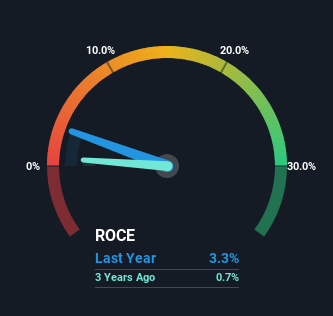Stock Analysis
- New Zealand
- /
- Infrastructure
- /
- NZSE:AIA
Returns On Capital Signal Tricky Times Ahead For Auckland International Airport (NZSE:AIA)

To find a multi-bagger stock, what are the underlying trends we should look for in a business? Ideally, a business will show two trends; firstly a growing return on capital employed (ROCE) and secondly, an increasing amount of capital employed. Ultimately, this demonstrates that it's a business that is reinvesting profits at increasing rates of return. However, after investigating Auckland International Airport (NZSE:AIA), we don't think it's current trends fit the mold of a multi-bagger.
What Is Return On Capital Employed (ROCE)?
Just to clarify if you're unsure, ROCE is a metric for evaluating how much pre-tax income (in percentage terms) a company earns on the capital invested in its business. Analysts use this formula to calculate it for Auckland International Airport:
Return on Capital Employed = Earnings Before Interest and Tax (EBIT) ÷ (Total Assets - Current Liabilities)
0.033 = NZ$359m ÷ (NZ$11b - NZ$567m) (Based on the trailing twelve months to December 2023).
Therefore, Auckland International Airport has an ROCE of 3.3%. In absolute terms, that's a low return but it's around the Infrastructure industry average of 3.8%.
Check out our latest analysis for Auckland International Airport

Above you can see how the current ROCE for Auckland International Airport compares to its prior returns on capital, but there's only so much you can tell from the past. If you're interested, you can view the analysts predictions in our free analyst report for Auckland International Airport .
What Can We Tell From Auckland International Airport's ROCE Trend?
In terms of Auckland International Airport's historical ROCE movements, the trend isn't fantastic. To be more specific, ROCE has fallen from 5.5% over the last five years. Although, given both revenue and the amount of assets employed in the business have increased, it could suggest the company is investing in growth, and the extra capital has led to a short-term reduction in ROCE. If these investments prove successful, this can bode very well for long term stock performance.
The Bottom Line
In summary, despite lower returns in the short term, we're encouraged to see that Auckland International Airport is reinvesting for growth and has higher sales as a result. In light of this, the stock has only gained 5.6% over the last five years. Therefore we'd recommend looking further into this stock to confirm if it has the makings of a good investment.
On a final note, we've found 1 warning sign for Auckland International Airport that we think you should be aware of.
If you want to search for solid companies with great earnings, check out this free list of companies with good balance sheets and impressive returns on equity.
Valuation is complex, but we're helping make it simple.
Find out whether Auckland International Airport is potentially over or undervalued by checking out our comprehensive analysis, which includes fair value estimates, risks and warnings, dividends, insider transactions and financial health.
View the Free AnalysisHave feedback on this article? Concerned about the content? Get in touch with us directly. Alternatively, email editorial-team (at) simplywallst.com.
This article by Simply Wall St is general in nature. We provide commentary based on historical data and analyst forecasts only using an unbiased methodology and our articles are not intended to be financial advice. It does not constitute a recommendation to buy or sell any stock, and does not take account of your objectives, or your financial situation. We aim to bring you long-term focused analysis driven by fundamental data. Note that our analysis may not factor in the latest price-sensitive company announcements or qualitative material. Simply Wall St has no position in any stocks mentioned.
About NZSE:AIA
Auckland International Airport
Auckland International Airport Limited provides airport facilities, supporting infrastructure, and aeronautical services in Auckland and New Zealand.
Moderate growth potential with acceptable track record.

